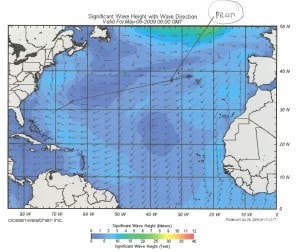 Captain Albert Schoonderbeek
Captain Albert Schoonderbeek
We continued our crossing with good weather. Partly Cloudy skies with a little swell that kept the ship just pitching a little bit. The weather is supposed to remain good but a broad band of clouds is coming over the North Atlantic so it is expected that from this evening until Lisbon we will have cloudy skies. No rain is expected although we see on the radar occasional small rain showers in the vicinity. Rain does reflect on the radar. Especially a dense rain down pour acts as a reflector to a normal radar beam. We can boost the radar waves so that they penetrate rain clouds. However most of the time we keep the radars on a nice weather setting as that setting gives a better reflection of normal targets. However, with seeing the rain clouds on the radar comes the option (if they are not too large) to sail around the clouds and in that way keep the ship dry.
While the weather remains very good, there is more swell predicted on the last stretch of our crossing to Punta Delgada. To the north of us, roughly on the line Halifax, Greenland, Scotland, the weather is not so good. Weather fronts with considerable wind are crossing the North Atlantic and these winds generate waves. If that lasts for some time then the waves become swell and a wave field, that can travel a considerable distance away from the area from where they were generated. Generally a wave field will travel in the direction of the path of the weather front and that is mostly North East or East. Thus in our case, sailing further to the South we do not notice that much. However some waves/swell will travel in other directions, basically in the same way as when you throw a stone in the water and see the ripples going in all directions. If you throw the stone under an angle the ripples will be stronger to one direction than towards another but still some ripples will go another way. It is the same with wave and swell generated by wind, and of course the stronger the wind, the higher the waves are whipped up and the more we will notice it eventually.
I have included a wave chart this time; a chart that I check each morning on the internet. It is of course important to know for the guests if we get wobbly weather but also how high the waves will be. This to see if they will affect the ships speed. The ships movement called pitching (up and down movement of the bow) can result in a significant reduction in speed if it goes from just a gentle movement to a more severe form. By the time the bow is slamming into the waves you can loose up to 25% of your speed.

The lighter the color; the higher the waves. As you can see the Prinsendam has been travelling through fairly dark blue area’s so we have had very little to content with.
While these wave fields are travelling over the ocean; they loose in principle momentum as the energy in the waves has to continue to energize new water masses to keep the momentum going. By leaving the area where the waves were generated, they come under the influence of different wave and wind patterns and as a result the waves and swell that we encounter on our cruise can be quite confused in appearance.
For the coming period we will be under the influence of waves and swell coming mainly from a North Easterly direction. As we are currently travelling in an Easterly direction, it causes the ship to Pitch and Roll as the ship encounters them under an angle. The rolling is taken care of by the stabilizers, the pitching we have to live with. Thus far no workable solution against this movement has been found, although there were some tests done in Japan in the past.
So from now to May 7, we will move a little bit until we reach the dock at Punta Delgada and after that probably as well.
To access Captain Albert’s historical writings on Holland America Line as well as photos and additional information about Prinsendam and his sailing schedule, click here.

Leave a Reply